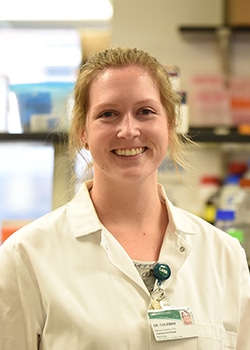Rachel A. Coleman – Research Investigator
Investigator:
Rachel A. Coleman, PhD
Name of Institution:
University of Alabama at Birmingham, Birmingham, AL
Project Title:
LRRK2 regulation of glucocerebrosidase activity: role of Rab10 and pathological characterization
Investigator Bio:
Dr. Coleman received her Bachelor of Science in Biochemistry from Auburn University in Alabama in 2016. During this time, she worked in the medicinal chemistry laboratory of Professor Stewart W. Schneller, designing and synthesizing molecules with antiviral properties. After enrolling in the Medicinal Chemistry and Molecular Pharmacology program at Purdue University in Indiana, Dr. Coleman performed her thesis work in the laboratory of Professor Darci Trader. This work explored enhancing proteasomal degradation of proteins as a therapeutic approach for Parkinson’s disease (PD). Once she received her PhD in December 2020, Dr. Coleman began as a post-doctoral fellow in PD research under the mentorship of Professor Laura Volpicelli-Daley in the Department of Neurology at the University of Alabama at Birmingham (UAB).
Objective:
To determine how LRRK2 activity modifies glucocerebrosidase activity through Rab10 and to characterize the pathological consequences of a LRRK2 mutation on sphingolipid metabolism and protein degradation in neurons.
Background:
A number of different gene mutations have been identified that increase an individual’s risk of developing PD. These gene mutations often result in abnormal activity of specific proteins, which contribute to disease development, but it is unclear how these proteins interact with each other. A recent study identified a regulatory mechanism between two proteins, LRRK2 and glucocerebrosidase (GCase), that are independently linked to PD. This study demonstrated that a mutation in LRRK2, which increases LRRK2 activity, causes a decrease in the activity of the lysosomal protein GCase. This was shown to occur through LRRK2-induced changes in Rab10, a known trafficking protein. We will probe this further to increase our understanding of the role of Rab10 in the relationship between LRRK2 and GCase.
Methods/Design:
We will evaluate how GCase moves to the lysosome (where breakdown of cellular waste takes place) in neuronal cultures that express mutated LRRK2 and compare these results to a wild-type control. GCase trafficking will be analyzed under several conditions, including in cells with too much or too little Rab10 to determine how these changes impact GCase trafficking.
We will also analyze Rab10, GCase, and LRRK2 expression levels in different brain areas (the hippocampus, midbrain, striatum, and cortex) of mice expressing the LRRK2 mutation and compare these results to a wild-type control. We will also evaluate GCase activity, various sphingolipid levels, and lysosomal function using the same models. These experiments will be performed in mice at different ages to determine if changes in protein levels, GCase activity, sphingolipid levels, or lysosomal function are age-dependent.
Relevance to Diagnosis/Treatment of Parkinson’s Disease:
Because the cause of PD is poorly understood, developing therapies that effectively prevent or even slow disease progression, rather than simply treating worsening symptoms, has proven challenging. This study therefore aims to identify a pathological pathway of PD, applicable to both sporadic and familial PD cases, that can be targeted for therapeutic intervention.

